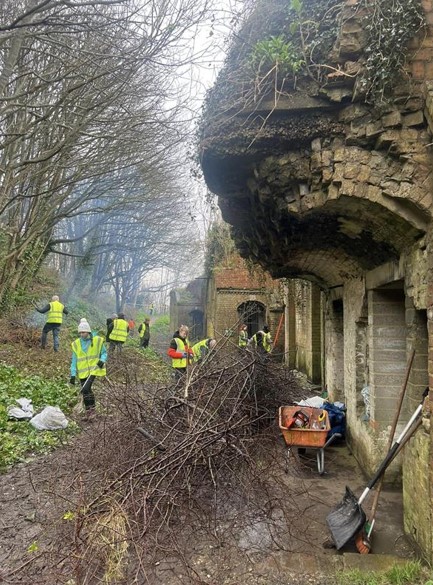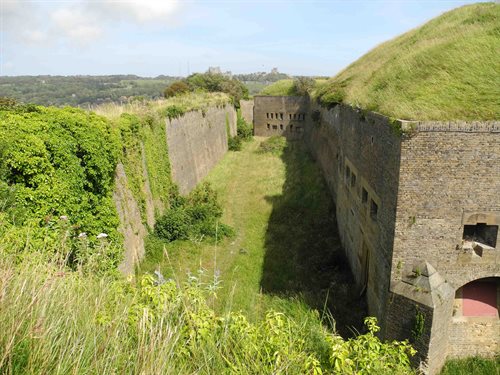Dover District Council is welcoming news that a new grant from Historic England is set to provide a key boost to help conserve and regenerate Dover’s nationally significant Western Heights. One of the most important and impressive fortifications in Britain, the Western Heights are a series of forts linked by miles of ditches on the western hilltop above Dover.
Historic England has awarded a grant to DDC for a three-year project to support conservation and regeneration work at Dover’s Western Heights and improve how this amazing asset connects with the town and waterfront.
The capacity building grant will fund a project officer who will deliver a range of work including coordinating and increasing volunteering opportunities, building visitor numbers through promotion and events, and the creation of a ‘vision’ document for the Western Heights. They will work closely with the Western Heights Preservation Society to continue the positive progress made to date.
DDC’s Cabinet agreed this week to accept the grant funding. The grant is for £149,000 and will be match-funded by DDC over the three year period.
The Western Heights is an extensive site of national importance, including a scheduled monument, two listed buildings, a conservation area, a local nature reserve with protected species, and a wildlife site with important chalk grassland.
The grant follows Dover’s Western Heights Masterplan which sets out a range of objectives, including to enhance the area as a destination of national and international significance, complementing Dover’s other heritage attractions.
The Regional Capacity Building Grant programme is for projects that promote the understanding, management and conservation of the historic environment.
Cllr Charlotte Zosseder, DDC Cabinet Member for Corporate Property, said: “We are delighted to receive this grant from Historic England. We look forward to working with all our partners to continue to enhance and regenerate this important area, and to develop how this connects to the range of amazing attractions in the town.”
Alice Brockway, Development Advice Team Leader at Historic England, said: “This grant will enable Dover District Council, their partners and local people to better understand, care for and enjoy the Western Heights - Dover’s second great fortress. This exciting project is the result of a shared vision to improve the area, provide better access, and celebrate this cherished place. We see this as an important step toward securing a long-term sustainable future for the fortress and making the most of Dover’s remarkable heritage.”
A Western Heights Preservation Society spokesperson said: “This is such good news. The backing of Historic England and Dover District Council is so important to the work we are doing on the Heights. It will mean that we will be able to do so much more in partnership with them and with English Heritage.”
Notes:
The Western Heights
One of the most important and impressive fortifications in Britain, the Western Heights are a series of strong points linked by miles of ditches on the western hilltop above Dover. They began as a series of field fortifications during the American Revolutionary War (1775-1783), were strengthened and extended in brick during the French Revolutionary and Napoleonic Wars (1792-1815), extended and amended again in the 1860s and were finally completed in the 1890s. The Heights were also used for barrack accommodation during the First and Second World Wars, and some of the fortifications adapted for modern warfare.
The Drop Redoubt is one of two independent forts on the Western Heights and is linked to the other, the Citadel, by a series of dry moats, or ‘lines’. It is a large and impressive fortress intended to defend against the attack of an invading force attempting to capture Dover from the north-east.
The Grand Shaft was built during the Napoleonic Wars to link the harbour to the barracks on the Western Heights. The Grand Shaft is a unique 19th century triple staircase built to provide a short cut for troops from the Western Heights to the town.
More information can be found regarding the work of the Western Heights Preservation Society on their website, and the society will be opening the Drop Redoubt to the public over the weekend of 22 and 23 June.
For more information on the Western Heights, and a range of other historic attractions in White Cliffs Country, please see the White Cliffs Country website.
Scheduled Monuments: Fortifications, Roman lighthouse and medieval chapel on Western Heights.
Listed structures: Administration Block and Grand Shaft Stairs and attached railings – both Grade II listed.
DDC Scrutiny
In accordance with Dover District Council’s Constitution, executive decisions made by Cabinet are subject to call-in by the Overview and Scrutiny Committee. The period for call-in expires four working days after the record of decision is published. Therefore, the information contained in this press statement may be subject to further review and changes and may not reflect the final decision.
Historic England
Historic England is the public body that helps people care for, enjoy and celebrate England’s spectacular historic environment, from beaches and battlefields to parks and pie shops. It protects, champions and saves the places that define who we are and where we’ve come from as a nation. It cares passionately about the stories they tell, the ideas they represent and the people who live, work and play among them. Working with communities and specialists it shares its passion, knowledge and skills to inspire interest, care and conservation, so everyone can keep enjoying and looking after the history that surrounds us all. Follow Historic England on social media @HistoricEngland


Posted on 11 April 2024